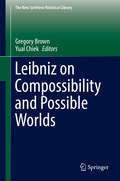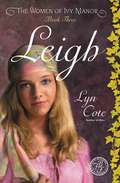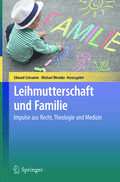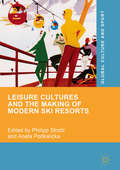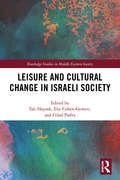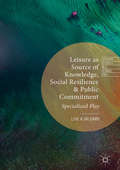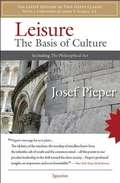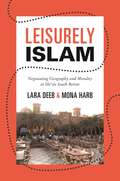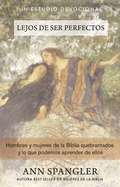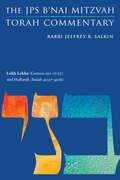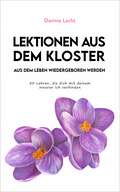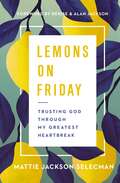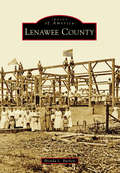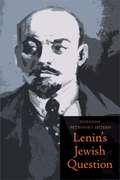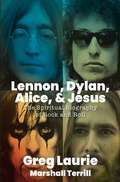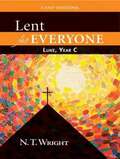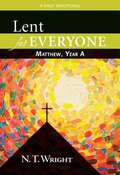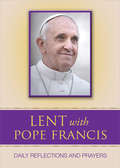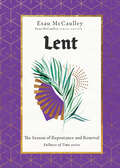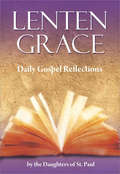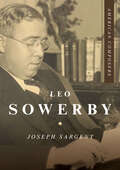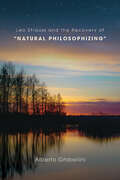- Table View
- List View
Leibniz on Compossibility and Possible Worlds
by Gregory Brown Yual ChiekThis volume brings together a number of original articles by leading Leibniz scholars to address the meaning and significance of Leibniz's notions of compossibility and possible worlds. In order to avoid the conclusion that everything that exists is necessary, or that all possibles are actual, as Spinoza held, Leibniz argued that not all possible substances are compossible, that is, capable of coexisting. In Leibniz's view, the compossibility relation divides all possible substances into disjoint sets, each of which constitutes a possible world, or a way that God might have created things. For Leibniz, then, it is the compossibility relation that individuates possible worlds; and possible worlds form the objects of God's choice, from among which he chooses the best for creation. Thus the notions of compossibility and possible worlds are of major significance for Leibniz's metaphysics, his theodicy, and, ultimately, for his ethics. Given the fact, however, that none of the approaches to understanding Leibniz's notions of compossibility and possible words suggested to date have gained universal acceptance, the goal of this book is to gather a body of new papers that explore ways of either refining previous interpretations in light of the objections that have been raised against them, or ways of framing new interpretations that will contribute to a fresh understanding of these key notions in Leibniz's thought.
Leibniz, God and Necessity
by Michael V. GriffinLeibniz states that 'metaphysics is natural theology', and this is especially true of his metaphysics of modality. In this book, Michael V. Griffin examines the deep connection between the two and the philosophical consequences which follow from it. Grounding many of Leibniz's modal conceptions in his theology, Griffin develops a new interpretation of the ontological argument in Leibniz and Descartes. This interpretation demonstrates that their understanding God's necessary existence cannot be construed in contemporary modal logical terms. He goes on to develop a necessitarian interpretation of Leibniz, arguing that Leibniz, like Spinoza, is committed to the thesis that everything actual is metaphysically necessary, but that Leibniz rejects Spinoza's denial of God's moral perfection. His book will appeal to scholars of early modern philosophy and philosophers interested in modal metaphysics and the philosophy of religion.
Leigh: Book Three in The Women of Ivy Manor
by Lyn CoteThe third in s series, this book focuses on a young journalist in the 1960s who becomes involved in the civil right movement and antiwar protests.
Leihmutterschaft und Familie: Impulse aus Recht, Theologie und Medizin
by Edward Schramm Michael WermkeDas Buch betrachtet das Thema Leihmutterschaft aus einer breit angelegten, interdisziplinären Perspektive. In Deutschland ist die Leihmutterschaft verboten, in vielen anderen Ländern legal. Viele Menschen erfüllen sich den Wunsch nach einem Kind daher im Wege einer Leihmutterschaft im Ausland. Das Buch nimmt dies zum Anlass, aktuelle Erkenntnisse und Impulse aus der Rechtswissenschaft, Theologie, Soziologie, kindlichen Entwicklungspsychologie, Medizin, Genetik und Philosophie zu diesem Phänomen aufzugreifen und zu analysieren. Im Mittelpunkt steht die Frage, inwiefern sich das Wohl des Kindes, die Interessen der Leihmütter sowie die Bedürfnisse der Wunscheltern in der deutschen Rechtsordnung, der sozialen Wirklichkeit und den kirchlichen Institutionen widerspiegeln.
Leisure Cultures and the Making of Modern Ski Resorts (Global Culture and Sport Series)
by Philipp Strobl Aneta PodkalickaThis edited volume offers an historical perspective on the creation of a global mass industry around skiing. By focusing on the ski resort as loci par excellence for global exchange, the contributors consider the development of skiing around the world during the crucial post-war years. With its global lens, Leisure Cultures and the Making of Modern Ski Resorts highlights both commonalities and differences between countries. Experts across various fields of research cover developments across the ski-able world, from Europe, Asia and America to Australia. Attention to media and material cultures reveals an insight into global fashions, consumption and ski cultures, and the impact of mainstream media in the 1960s and 1970s. This global and interdisciplinary approach will appeal to history, sociology, cultural and media research scholars interested in a cultural history of skiing, as well as those with more broad interests in globalization, consumption research, and knowledge transfer.
Leisure and Cultural Change in Israeli Society (Routledge Studies in Middle Eastern Society)
by Elie Cohen-Gewerc Gilad Padva Tali HayoshProviding an inclusive, yet multi-layered perspective on leisure cultures in dynamic hegemonic, subcultural, and countercultural communities, this volume investigates the disciplinary and interdisciplinary aspects of leisure studies in the age of mass migration, nationalism, cultural wars, and conflicted societies in Israel. The Israeli society struggles with complicated geopolitical, intercultural, economic and security conditions since the establishment of the State of Israel. Consequently, the emergent leisure cultures in Israel are vibrant, diversified, exuberant and multifaceted, oscillating between Western and Middle Eastern tendencies. The chapters in this edited volume reflect dramatic influences of globalization on Israeli traditions, on one hand, and emergent local practices that reflect a communal quest of originality and authenticity, on the other hand. This book opens up a critical perspective on the tension between contested leisure cultures which are interconnected with spatial and temporal changes and interchanges. Examining leisure as a part of social, interethnic, physical, gendered and sexual changes, the volume is a key text for scholars and students interested in leisure culture, Israeli society, education, cultural and media studies and the Middle East.
Leisure as Source of Knowledge, Social Resilience and Public Commitment: Specialized Play (Leisure Studies in a Global Era)
by Lise KjølsrødThis book provides a bottom-up contribution to contemporary political and cultural theory, by presenting leisure activities as a democratic arena. Where much of the existing literature on leisure and play views participants as consumers, Kjølsrød presents these people as producers, who conduct micro-processes of social protection, become informed and skilled, and achieve influence via complex leisure. Through an in-depth analysis of a range of leisure practices, this book demonstrates where players belong in the political landscapes of modern democracies. Leisure as Source of Knowledge, Social Resilience and Public Commitment will be of interest to students and scholars of leisure, recreational, and cultural studies, as well as sociologists, anthropologists and political scientists studying identity construction, emerging social worlds, and novel channels of political participation in contemporary society.
Leisure: The Basis of Culture and The Philosophical Act
by Josef Pieper"One of the most important philosophy titles published in the twentieth century, Josef Pieper's Leisure, the Basis of Culture is more significant, even more crucial, today than it was when it first appeared more than fifty years ago. This special new edition now also includes his little work The Philosophical Act. Leisure is an attitude of the mind and a condition of the soul that fosters a capacity to perceive the reality of the world. Pieper shows that the Greeks and medieval Europeans, understood the great value and importance of leisure. He also points out that religion can be born only in leisure - a leisure that allows time for the contemplation of the nature of God. Leisure has been, and always will be, the first foundation of any culture. Pieper maintains that our bourgeois world of total labor has vanquished leisure, and issues a startling warning: Unless we regain the art of silence and insight, the ability for non-activity, unless we substitute true leisure for our hectic amusements, we will destroy our culture - and ourselves. "Pieper's message for us is plain. . . . The idolatry of the machine, the worship of mindless know-how, the infantile cult of youth and the common mind - all this points to our peculiar leadership in the drift toward the slave society. . . . Pieper's profound insights are impressive and even formidable. "- New York Times Book Review "Pieper has subjects involved in everyone's life; he has theses that are so counter to the prevailing trends as to be sensational; and he has a style that is memorably clear and direct. " - Chicago Tribune"
Leisurely Islam: Negotiating Geography and Morality in Shi‘ite South Beirut (Princeton Studies in Muslim Politics #49)
by Lara Deeb Mona HarbHow the rise of leisure is changing contemporary LebanonSouth Beirut has recently become a vibrant leisure destination with a plethora of cafés and restaurants that cater to the young, fashionable, and pious. What effects have these establishments had on the moral norms, spatial practices, and urban experiences of this Lebanese community? From the diverse voices of young Shi'i Muslims searching for places to hang out, to the Hezbollah officials who want this media-savvy generation to be more politically involved, to the religious leaders worried that Lebanese youth are losing their moral compasses, Leisurely Islam provides a sophisticated and original look at leisure in the Lebanese capital.What makes a café morally appropriate? How do people negotiate morality in relation to different places? And under what circumstances might a pious Muslim go to a café that serves alcohol? Lara Deeb and Mona Harb highlight tensions and complexities exacerbated by the presence of multiple religious authorities, a fraught sectarian political context, class mobility, and a generation that takes religion for granted but wants to have fun. The authors elucidate the political, economic, religious, and social changes that have taken place since 2000, and examine leisure's influence on Lebanese sociopolitical and urban situations.Asserting that morality and geography cannot be fully understood in isolation from one another, Leisurely Islam offers a colorful new understanding of the most powerful community in Lebanon today.
Lejos de mi sombra: Cerca de la luz
by Barbara PalaciosLejos de mi sombra... cerca de la luz nos proporciona lecciones prácticas para luchar en contra del estallido de conflictos emocionales, en una travesía plena de espiritualidad que nos conduce a examinarnos internamente y desafiarnos ante una mejor administración de nuestra vida emocional. Un buen ejercicio de nuestra pasión por vivir, una mejor guía para nuestros pensamientos, para nuestros valores y para nuestra subsistencia, son entre otros los beneficios que reporta este novedoso aporte editorial de Bárbara Palacios. Lejos de mi sombra... cerca de la luz constituye una verdadera expresión de conceptos e ideas prácticas en 5 capítulos, estructurados así:Arropado en tu sombraDetecta tus hábitos negativosSin mirar hacia atrásCrece en control emocionalCerca de la Luz
Lejos de ser perfectos: Hombres y mujeres de la Biblia quebrantados y lo que podemos aprender de ellos
by Ann Spangler¿Qué pueden revelar los hombres y mujeres más imperfectos de la Biblia sobre quién es Dios y cómo se comunica con usted y conmigo? La exitosa autora Ann Spangler nos lleva más allá de la imagen estereotipada de treinta y ocho personajes bíblicos, para presentarlos como personas reales que tenían sueños, tentaciones y debilidades al igual que nosotros.Ya sea considerando a la asesina Herodías, al conspirador Jacob o a la dudosa Sara, Spangler se acerca tanto a los personajes más famosos como a los menos conocidos, con una mirada distinta. Nos encontramos nuevamente con cada una de estas personas como si fuera la primera vez, dado que la autora ofrece una nueva versión dramática de sus vidas, una visión del contexto histórico y cultural de su tiempo, y enseñanzas clave para nuestra vida en la actualidad. Cada capítulo incluye preguntas para el debate o reflexión, lo que hace que este material sea ideal para el estudio bíblico individual o grupal.Entretenido, informativo e inspirador, este libro ofrece una visión general de la Biblia, incluso cuando lo conduce a ver los corazones y las mentes de gente con luchas como la suya. A medida que aprende más sobre los individuos que forman parte de su árbol genealógico espiritual, descubrirá por qué a Dios le encanta usar personas imperfectas para contar su historia perfecta de redención.
Lekh Lekha: The JPS B'nai Mitzvah Torah Commentary (JPS Study Bible)
by Rabbi Jeffrey K. SalkinLekh Lekha (Genesis 12:1-17:27) and Haftarah (Isaiah 40:27-41:16): The JPS B’nai Mitzvah Torah Commentary shows teens in their own language how Torah addresses the issues in their world. The conversational tone is inviting and dignified, concise and substantial, direct and informative. Each pamphlet includes a general introduction, two model divrei Torah on the weekly Torah portion, and one model davar Torah on the weekly Haftarah portion. Jewish learning—for young people and adults—will never be the same. The complete set of weekly portions is available in Rabbi Jeffrey K. Salkin’s book The JPS B’nai Mitzvah Torah Commentary (JPS, 2017).
Lektionen aus dem Kloster: Aus dem Leben wiedergeboren werden - 33 Erkenntnisse, die dich mit deinem inneren Ich verbinden
by Davinia Lacht„Lektionen aus dem Kloster“ enthält 33 elementare Lehren, die dir zeigen, wie du wieder zu deinem Mittelpunkt der Stille zurückfindest, um den Alltag aus Frieden und Harmonie heraus zu bestreiten. Anhand von praktischen Beispielen und Erlebnissen der Autorin entdeckst du, wie die geistliche Welt alle Aspekte deines Lebens umfasst und dass du schon hier und jetzt dazu bereit bist, dir den Weg der Liebe zu erschließen. Gewähre deinen Beziehungen Heilung, genieße das Alltägliche und lass dich von den Stimmen der Stille leiten. Dieses Buch will dich dazu einladen, deine unentbehrliche Rolle in der Welt zu entdecken und zu verstehen, dass du dich nur dann vollständig fühlen wirst, wenn du diese Rolle einnimmst. Das Leben ist einfach und es ist dein Geburtsrecht, glücklich zu sein, deine Beziehung zu deinem Nächsten zu ehren und bedingungslos im gegenwärtigen Moment zu leben. Entdecke das Licht, das in dir lebt. Bist du bereit? Die Lektionen dieses Buches entspringen der Zeit, die Davinia Lacht in der Klostergemeinschaft von Taizé in Frankreich verbrachte. Über ein Jahr lang verknüpfte sie Stille, Dienst und das Leben in einer Gemeinschaft miteinander und löste sich währenddessen von den inneren Stimmen, die nicht von der Liebe sprechen.
Lemons on Friday: Trusting God Through My Greatest Heartbreak
by Mattie Jackson SelecmanAfter being married for less than a year, country music legend Alan Jackson&’s daughter Mattie was faced with navigating a future that didn&’t include her young husband and their lifelong plans.Ben Selecman passed away twelve days after a traumatic brain injury—and three weeks before celebrating his first anniversary with his wife. Twenty-eight-year-old Mattie had to find a way to move forward and reconcile herself with a good God, even when He did not give her the healing miracle she prayed for. In Lemons on Friday, readers walk with Mattie Jackson Selecman during the first years of grief following Ben&’s tragic death as she grapples with her loss and leans on a steadfast God. Based on Selecman&’s journal writings, Lemons on Friday will speak to all readers who must carry on without their loved ones and take a hard look at faith when their lives have not gone as planned.Lemons on Friday grapples with questions like these:How did I get here?Will this always hurt?Who am I now?How do I move forward?&“When fundamental parts of our lives are lost, when people and things we thought we&’d never lose are suddenly gone, it&’s natural to want answers,&” writes Selecman. &“Why did this happen? Who&’s to blame? What could I have done differently? And for many of us in the aftermath of life-shattering change, we also want to know, where is God? Not just where was He when the tragedy happened, but where is He now in my darkest days of hurt, wondering, and longing for comfort? When I am on the floor, writhing in tears with no idea what the rest of my life will look like, where is God?&” Lemons on Friday offers insight and peace for anyone grieving, but especially for young people experiencing loss and facing a future that feels full of question marks.
Lenawee County (Images of America)
by Brenda L. BurkettIn 1822, Gov. Lewis Cass defined the boundaries of six counties, including Lenawee. The Pottawattamies inhabited Lenawee County before settlers, many of Quaker descent, migrated from eastern states, predominantly New York. Abundant forests, prairies, hills, lakes, and streams surrounded by uncultivated fruit, berries, nuts, and wild game had enabled the county to lead the state in agricultural and industrial wealth by 1900. This early success is also partially owed to the establishment of the Grange by George B. Horton in 1873. Lenawee led the state with 34 Granges and more than 3,500 members by the turn of the century. Adrian would become known as the fence capital of the world, while Tecumseh was referred to as the celery capital. Michigan’s first cheese factories began in Fairfield Township in 1866, with Samuel Horton creating a new form of soft cheese. Recognition of the historical significance of this area is shown throughout the region today with landmarks that pay tribute to the pioneers.
Lenin's Jewish Question
by Yohanan Petrovsky-ShternIn this first examination of Lenin’s genealogical and political connections to East European Jews, Yohanan Petrovsky-Shtern reveals the broad cultural meanings of indisputable evidence that Lenin’s maternal grandfather was a Jew. He examines why and how Lenin’s Jewish relatives converted to Christianity, explains how Lenin’s vision of Russian Marxism shaped his identity, and explores Lenin’s treatment of party colleagues of Jewish origin and the Jewish Question in Europe. Petrovsky-Shtern also uncovers the continuous efforts of the Soviet communists to suppress Lenin’s Jewishness and the no less persistent attempts of Russian extremists to portray Lenin as a Jew. In this fascinating book, Petrovsky-Shtern expands our understanding not only of Lenin, but also of Russian and Soviet handling of the Jewish Question.
Lennon, Dylan, Alice, and Jesus: The Spiritual Biography of Rock and Roll
by Greg LaurieA nationally best-selling author and pastor draws lessons of hope and transformation in the perils of excess, the agonies of repentance, and the wonder of redemption found in the life stories of several icons of pop music and rock and roll. From the author of Johnny Cash: The Redemption of an American Icon and Steve McQueen: The Salvation of an American Icon comes Lennon, Dylan, Alice, and Jesus, which traces the journeys, rise, fall, and sometimes the redemption of famous entertainers who were brought to their knees—a great place to look up and finally meet their Maker. Lennon, Dylan, Alice, and Jesus examines wretched excess, self-absorption and miraculous redemption; the book is a raw, sensitive, and unforgettable journey of sex, drugs, rock and roll, and sweet salvation. Author Greg Laurie traces the lives of rock stars and entertainment figures and legends who wallowed in the decadence of both the high life and low life, as they alternately experienced Heaven and Hell on Earth. He travels with them into their demonic abysses and joyfully chronicles their ultimate ascension to their prodigal moments. Lennon, Dylan, Alice, and Jesus chronicles the birth of rock and roll in the mid-1950s to today, giving the book an all-encompassing study of pop music history. Through his personal memories, coupled with his carefully crafted observational research, Greg Laurie not only looks deeply into the hearts and souls of these unusual people but bids the reader to join him on a spiritual journey down the secluded halls of the music industry with the individuals who crafted modern-day masterpieces. Readers will enjoy never-before-published accounts of the biggest recording artists of our time and hear testimonies from rockers of the 1950s, 1960s, 1970s, 1980s, 1990s, 2000s, and beyond. More importantly, every reader will find a deeper sense of God&’s presence, even in times of loneliness and desolation.
Lent for Everyone
by N. T. WrightA Lent lectionary resource using Tom Wright's For Everyone Bible translation, this is the third in a three-volume series to cover the three years of the Revised Common Lectionary. For each day of Lent, there is a reading chosen from the Gospel designated for the year, plus a reflection by Tom Wright.
Lent for Everyone: Matthew, Year A
by Nicholas ThomasLent for Everyone: Matthew, Year A provides readers with an inspirational guide through the Lenten season, from Ash Wednesday through the week after Easter. Popular biblical scholar and author N. T. Wright provides his own Scripture translation, brief reflection, and a prayer for each day of the season, helping readers ponder how the text is relevant to their own lives. By the end of the book, readers will have been through the entirety of Matthew, along with Psalm readings for each Sunday. Suitable for both individual and group study and reflection, Wright's Lenten devotional will help make Matthew's gospel your own, thoughtfully and prayerfully, and your journey through Lent a period of discovery and growth.
Lent with Pope Francis
by The Daughters of St. PaulStarting with Ash Wednesday, Lent with Pope Francis draws from his homilies, public addresses, and other writings to encourage you as you journey towards Easter. Continuing through Easter Week, the Holy Father touches on the basic elements of Lent -- prayer, fasting, and almsgiving -- and takes each one deeper, digging for the true spirit of the issue. Join Pope Francis this Lent as you make your way towards Easter. Let him inspire and support you during your Lenten journey.
Lent: The Season of Repentance and Renewal (The\fullness Of Time Ser.)
by Esau McCaulley"Lent is inescapably about repenting."Often, though, we experience the Lenten fast as either a mindless ritual or self-improvement program. In this short volume, priest and scholar Esau McCaulley introduces the season of Lent, showing us how its prayers and rituals point us not just to our own sinfulness but also beyond it to our merciful Savior.Each volume in the Fullness of Time series invites readers to engage with the riches of the church year, exploring the traditions, prayers, Scriptures, and rituals of the seasons of the church calendar.
Lenten Grace
by Daughters of St. PaulIn this daily Lenten companion, members of the Daughters of St. Paul guide readers in lectio divina on the Scripture readings for the season. Includes the text of the Exultet with reflections for the Octave of Easter
Leo Sowerby (American Composers)
by Joseph SargentFrom the 1920s to the 1940s, Leo Sowerby created popular secular works while his sacred compositions led admirers to call him the “dean of American church musicians.” Yet in time, Sowerby’s Pulitzer Prize-winning The Canticle of the Sun and the rest of his corpus lost favor with the A-list symphonies and prominent musicians who had once made him a fixture in their repertoires. Joseph Sargent’s biography offers the first focused study of Sowerby’s life and work against the backdrop of the composer’s place in American music. As Sargent shows, Sowerby’s present-day marginalization as a composer relates less to the quality of his work than the fact that today’s historiographical practices and canon-building activities minimize modern church music. Sargent’s re-evaluation draws on a wide range of perspectives and composer’s music and writings to enrich detailed analyses of musical works and a career-spanning consideration of Sowerby’s musical language and aesthetic priorities.
Leo Strauss and The Theologico-Political Problem
by Heinrich MeierThis book, by one of the most prominent interpreters of Leo Strauss's thought, was the first to address the problem that Leo Strauss himself said was the theme of his studies: the theologico-political problem or the confrontation with the theological and the political alternative to philosophy as a way of life. In his theologico-political treatise, which comprises four parts and an appendix, Heinrich Meier clarifies the distinction between political theology and political philosophy and reappraises the unifying center of Strauss's philosophical enterprise. The book is the culmination of Meier's work on the theologico-political problem. It will interest anyone who seeks to understand both the problem caused by revelation for philosophy and the challenge posed by political-religious radicalism. The appendix makes available for the first time two lectures by Strauss that are immediately relevant to the subject of this book and that will open the way for future research and debate on the legacy of Strauss.
Leo Strauss and the Recovery of "Natural Philosophizing" (SUNY series in the Thought and Legacy of Leo Strauss)
by Alberto Marco GhibelliniAmong the political philosophers of the twentieth century, Leo Strauss is usually singled out for his attempt to revitalize the ancient approach to counter the relativism of both historicism and positivism. It is less commonly underscored, however, that the cornerstone of this attempt is the recovery of the question of "nature," which he regarded as inseparable from genuine philosophy since its inception in ancient Greece. Leo Strauss and the Recovery of "Natural Philosophizing" addresses such a theme, focusing on the theoretical presuppositions that Strauss found at the basis of the acquired inability to raise the question of nature. Prominent among these is the encounter between philosophy and revelation, which, due to their conceptual incompatibility, leads to a condition Strauss metaphorically described as a "second, 'unnatural' cave" characterized by insurmountable "prejudices" rather than "appearance and opinion." These, however, are the starting point of genuine philosophy in the Platonic "first, 'natural' cave," which has to be regained, by way of historical deconstruction of the presuppositions of the second cave, if the "natural philosophizing" embodied by Socratic dialectics is to be reactivated.
